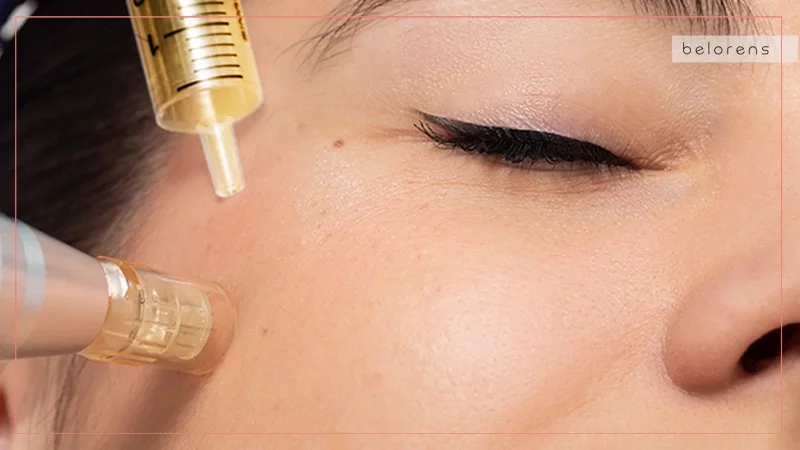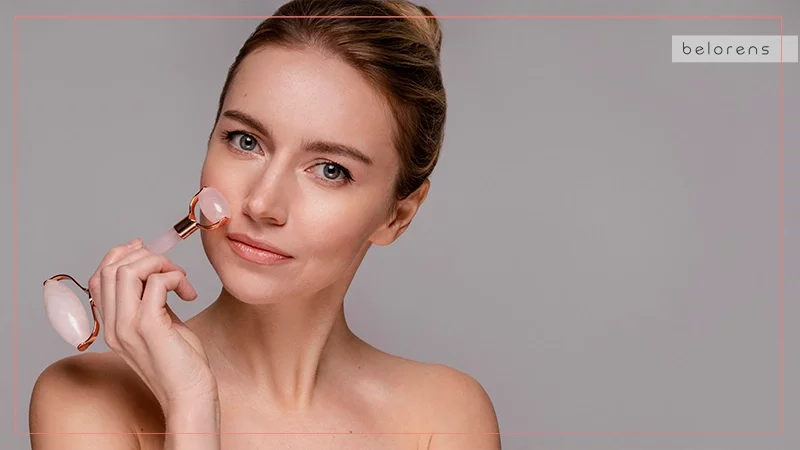Published on 29 Sep 2024
Aging Gracefully: Skincare Secrets for Your 40s and Beyond
- ByMedical Content Team
- Medically Reviewed byDr. Sabine Kulhanek
Fact checked

As we journey through our 40s, our skin tells the story of our lives—every laugh line, sun-kissed freckle, and late-night wrinkle a testament to our unique experiences. Embracing this new chapter with a proactive skincare routine not only preserves our skin’s health but also enhances its natural beauty.
This blog post aims to guide you through the intricacies of facial care after 40, offering actionable tips and expert advice to help you navigate this new stage in your skincare journey. Whether you're dealing with fine lines, age spots, or simply looking to enhance your skin's radiance, we've got you covered. Let's find out how you can keep your skin looking its best, regardless of age.
Signs of aging skin
During our 40s, several visible signs indicate that our skin is aging. Fine lines and wrinkles are among the first noticeable signs. These small, thin lines often appear around the eyes, known as crow’s feet, as well as around the mouth and on the forehead. They are caused by reduced collagen and elastin production, repeated facial expressions, and loss of skin moisture.
Age spots and hyperpigmentation are other common signs of aging skin, manifesting as dark, flat spots on the skin, especially on the face, hands, and arms. These occur due to prolonged sun exposure, which leads to an overproduction of melanin in certain areas.
As the skin feels tight, rough, or flaky due to decreased oil production, environmental factors, and slower cell turnover, in your 40s, dryness and dehydration become more prominent. In addition, loss of firmness and elasticity is evident as the skin starts to appear saggy or loose, particularly around the jawline and cheeks. This is primarily due to the decreased production of collagen and elastin, combined with gravity and the loss of fat in the deeper layers of the skin.
Thinning skin is another sign, when the skin becomes more delicate and prone to bruising. This results from the thinning of the dermal layer, which offers less protection and cushioning.
Also Read: Aging Eyes: 5 Common Signs and How to Reverse Them
Why does our skin start to change in our 40s?

As we enter our 40s, several biological and environmental factors contribute to the visible signs of aging in our skin. These factors are either biological or environmental.
Biological factors
- Decreased collagen production: Collagen is a protein that provides structure, elasticity, and strength to the skin. In our 40s, the production of collagen slows down significantly. This reduction leads to the thinning of the skin and the formation of fine lines and wrinkles.
- Reduced elastin: Elastin is another crucial protein responsible for the skin's ability to return to its original shape after stretching or contracting. As we age, the production of elastin also decreases, resulting in less elastic and more saggy skin.
- Slower cell turnover: Cell turnover is the process by which the skin sheds old, dead cells and replaces them with new ones. This process slows down with age, causing a buildup of dead skin cells that can make the skin look dull, rough, and uneven.
- Decreased oil production: Sebaceous glands produce natural oils that keep the skin moisturized. In our 40s, these glands become less active, leading to drier skin that is more prone to fine lines and wrinkles.
- Hormonal changes: Hormonal fluctuations, particularly a decrease in estrogen, can significantly impact the skin's health. Estrogen helps maintain skin thickness, moisture, and elasticity. As its levels drop, the skin becomes thinner, drier, and less elastic.
Environmental factors

- Sun exposure: Prolonged and unprotected exposure to ultraviolet (UV) rays is one of the primary causes of premature aging. UV rays break down collagen and elastin fibers in the skin, leading to wrinkles, age spots, and an increased risk of skin cancer.
- Pollution: Exposure to environmental pollutants can accelerate the aging process. Pollutants generate free radicals, which cause oxidative stress and damage to the skin cells, leading to premature aging signs such as wrinkles and dark spots.
- Lifestyle choices: Lifestyle factors such as smoking, alcohol consumption, and poor diet can significantly impact skin health. Smoking reduces blood flow to the skin, depriving it of oxygen and essential nutrients, while excessive alcohol consumption can dehydrate the skin. A diet lacking in essential vitamins and antioxidants can also accelerate the aging process.
- Stress: Chronic stress can have a detrimental effect on the skin. Stress triggers the release of cortisol, a hormone that can break down collagen and elastin, leading to increased signs of aging.
How to care for your skin in your 40s: 5 tips that work miracle
As we enter our middle age, maintaining a dedicated and effective skincare routine becomes increasingly important. After the age of 40, our skin requires more targeted care to address the changes it undergoes. Here’s a comprehensive guide to help you keep your skin healthy, radiant, and youthful in your midlife.
Incorporate retinol into your routine
Retinol, a derivative of Vitamin A, is a powerful ingredient that can significantly improve the appearance of aging skin. It is a potent ingredient that can improve skin texture, reduce the appearance of fine lines and wrinkles, and promote a more youthful complexion by promoting cell turnover and stimulating collagen production.
Retinol can be potent, and it's essential to introduce it gradually into your skincare routine to allow your skin to adjust. Begin by using it once or twice a week. For beginners, a lower concentration (0.25% to 0.5%) is recommended. As your skin builds tolerance, you can gradually increase the concentration to 1%. As for the right amount, a little goes a long way. Use only a pea-sized amount for your entire face.
Retinol can make your skin more sensitive to the sun, so it’s best to use it in your evening skincare routine or use a broad-spectrum sunscreen with at least SPF 30 during the day. Apply it after cleansing and toning, but before moisturizing. Avoid the delicate skin around your eyes and mouth unless the product is specifically formulated for those areas.
Since retinol can be drying, it's essential to follow up with a good moisturizer. Look for products containing hyaluronic acid, ceramides, or glycerin to help lock in moisture. It’s important to pay attention to how your skin responds. Some redness, dryness, or peeling is normal initially. If irritation occurs, reduce the frequency of use or switch to a lower concentration.
Retinol can be irritating if used with other potent active ingredients like alpha hydroxy acids (AHAs), beta hydroxy acids (BHAs), or Vitamin C. If you want to use these products, alternate them with retinol on different nights.
It takes time for retinol to show results. It can take several weeks to notice improvements in your skin’s texture and tone. Consistency is key, so stick with your routine.
Hydrate, hydrate, hydrate

As we age, our skin tends to become drier due to decreased oil production. Keeping your skin well-hydrated is crucial for maintaining a healthy and youthful appearance after the age of 40. Proper hydration helps to maintain the skin’s elasticity, reduces the appearance of fine lines and wrinkles, and promotes a radiant complexion.
To effectively hydrate your skin, incorporate a rich moisturizer into your daily skincare routine. Look for products that contain hydrating ingredients such as hyaluronic acid, glycerin, and ceramides. Hyaluronic acid is a powerful humectant that attracts and retains moisture in the skin, glycerin helps to draw water from the air into the skin’s outer layer, and ceramides help to restore the skin barrier and lock in moisture.
In addition to using topical products, it’s essential to stay hydrated from the inside out. Drink plenty of water throughout the day to keep your skin hydrated and support overall health. Aim for at least 8 glasses of water daily, and consider increasing your intake if you’re active or live in a dry climate. Eating a diet rich in water-dense fruits and vegetables, such as cucumbers, watermelon, and oranges, can also contribute to your hydration levels.
By maintaining proper hydration, you can help keep your skin plump, smooth, and glowing, combating the dryness that often accompanies aging.
Protect your skin from the sun
Sun protection is essential at any age, but it's particularly important after 40 to prevent further damage and aging. Exposure to ultraviolet (UV) rays from the sun can accelerate the breakdown of collagen and elastin fibers, leading to wrinkles, sun spots, and an increased risk of skin cancer. Incorporating sun protection into your daily routine is crucial for maintaining healthy, youthful skin.
To effectively protect your skin from the sun, use a broad-spectrum sunscreen with an SPF of 30 or higher every day, even on cloudy days and during the winter. Broad-spectrum sunscreens protect against both UVA and UVB rays, which can cause premature aging and skin cancer. Apply sunscreen generously to all exposed skin, including your face, neck, and hands, at least 15 minutes before going outside. Reapply every two hours, or more frequently if you are swimming or sweating.
In addition to sunscreen, consider wearing protective clothing, such as long-sleeved shirts, pants, wide-brimmed hats, and sunglasses. These items can provide an extra layer of defense against harmful UV rays. Look for clothing with a high UPF (ultraviolet protection factor) rating for the best protection.
Seeking shade, especially during peak sun hours from 10 a.m. to 4 p.m., can also help minimize sun exposure. If you need to be outside during these times, try to stay in the shade as much as possible and use additional protective measures.
By consistently protecting your skin from the sun, you can prevent further damage, maintain a more youthful appearance, and reduce the risk of skin cancer. This essential step in your skincare routine after 40 can make a significant difference in the long-term health and beauty of your skin as you reach older ages.
Exfoliate regularly

Regular exfoliation is key to maintaining vibrant, youthful skin, especially as you age. Exfoliating helps remove dead skin cells that can accumulate on the surface, leading to a dull and uneven complexion. It promotes cell turnover, allowing fresh, new skin to emerge, which can improve texture, tone, and overall radiance.
To effectively exfoliate your skin, choose between chemical and physical exfoliants based on your skin type and sensitivity. Chemical exfoliants, such as alpha hydroxy acids (AHAs) and beta hydroxy acids (BHAs), work by dissolving the bonds between dead skin cells, making them easier to remove. AHAs, like glycolic and lactic acid, are water-soluble and best for dry or sun-damaged skin, while BHAs, like salicylic acid, are oil-soluble and excellent for oily or acne-prone skin.
Physical exfoliants involve using a scrub or tool to manually remove dead skin cells. When opting for physical exfoliation, choose products with fine, gentle particles to avoid irritating or damaging the skin. Exfoliating once or twice a week is typically sufficient for most skin types. Over-exfoliating can strip the skin of its natural oils and lead to irritation, so it's crucial to find a balance that works for you.
Incorporating exfoliation into your skincare routine can help to minimize the appearance of fine lines, unclog pores, and improve the effectiveness of other skincare products by allowing them to penetrate deeper. By regularly removing the buildup of dead skin cells, you can maintain a smoother, brighter, and more youthful complexion in your 40s and beyond.
Also Read: The Ultimate Guide to Making a Skincare Routine: Tips for Healthy Skin
Adopt a healthy lifestyle
Adopting a healthy lifestyle plays a crucial role in maintaining youthful, vibrant skin, particularly as you enter middle age. Your daily habits, diet, and overall well-being significantly impact your skin's appearance and health.
Diet and nutrition
Eating a balanced diet rich in antioxidants, vitamins, and minerals supports skin health from the inside out. Include plenty of fruits, vegetables, nuts, seeds, and fatty fish in your diet. Antioxidant-rich foods, such as berries, spinach, and nuts, help fight free radicals that can damage skin cells. Omega-3 fatty acids found in fish like salmon and chia seeds can help maintain the skin’s lipid barrier, keeping it hydrated and supple.
Hydration
Staying hydrated is essential for healthy skin. Drink plenty of water throughout the day to help maintain skin elasticity and moisture. Proper hydration aids in flushing out toxins, which can contribute to clearer, healthier skin.
Exercise
Regular physical activity improves circulation, which helps deliver oxygen and nutrients to the skin. Exercise also promotes the removal of toxins through sweat and can reduce stress levels, contributing to a healthier complexion. Aim for at least 30 minutes of moderate exercise most days of the week.
Sleep
Quality sleep is vital for skin repair and regeneration. During sleep, your body increases blood flow to the skin and boosts collagen production, which helps repair damage and maintain skin elasticity. Aim for 7-9 hours of sleep per night to allow your skin adequate time to rejuvenate.
Stress management
Chronic stress can negatively impact your skin by increasing the production of cortisol, a hormone that can break down collagen and elastin. Managing stress through activities like yoga, meditation, or hobbies can help maintain your skin's health. Techniques such as deep breathing exercises, mindfulness, and regular relaxation can reduce stress levels and its detrimental effects on the skin.
Avoid harmful habits
Smoking and excessive alcohol consumption can accelerate the aging process. Smoking restricts blood flow to the skin, depriving it of essential nutrients and oxygen, while alcohol can dehydrate the skin and reduce its elasticity. Avoiding these habits can significantly improve your skin's overall health and appearance.
By adopting a healthy lifestyle, you can enhance your skin’s natural glow, maintain its elasticity, and slow down the signs of aging after 40. This holistic approach ensures that your skin remains healthy and youthful from the inside out.
Top professional skin treatments for after 40

If you’re experiencing skin issues despite following skincare tips and advice, there are several professional treatments that can make a significant difference, especially after 40. Here are some of the most effective options:
- Injectables: Neurotoxins like Botox can help relax muscles to reduce wrinkles, while dermal fillers can add volume to smooth out lines and wrinkles.
- Microneedling with PRP: Microneedling involves using tiny needles to create micro-injuries in the skin, which stimulates collagen production. When combined with Platelet-Rich Plasma (PRP), it can enhance the skin’s texture and tone.
- Laser resurfacing: Laser skin resurfacing uses lasers to remove layers of skin, promoting new skin growth and improving the appearance of fine lines, wrinkles, and scars.
- Chemical peels: Chemical peels involve applying a chemical solution to the skin, which exfoliates and eventually peels off, revealing smoother and more even-toned skin underneath.
- Ultrasound treatments: Ultrasound treatment or HIFU uses ultrasound energy to stimulate collagen production deep within the skin, which can help lift and tighten sagging skin.
- Radiofrequency treatments: These use radiofrequency energy to heat the skin, stimulating collagen production and improving skin laxity and texture.
- Thread lifts: A thread lift is a minimally invasive procedure that involves inserting threads under the skin to lift and tighten sagging areas.
- Skin tightening treatments: Non-invasive treatments like Thermage or Ultherapy use heat to stimulate collagen production, resulting in firmer, tighter skin.
- Dermabrasion: dermabrasion is a non-invasive procedure that exfoliates the skin using a special device to remove dead skin cells, improving skin texture and tone.
It’s always best to consult with a dermatologist or skincare professional to determine which treatments are most suitable for your specific skin concerns. They can provide personalized recommendations based on your skin type and condition.
Also Read: 5 Skin Procedures You Should Avoid During The Summertime
Takeaway

As we age, our skin undergoes significant changes, often requiring us to adjust our facial care routines to maintain a healthy, youthful appearance. After the age of 40, these changes become more pronounced due to reduced collagen production, decreased elasticity, and increased dryness. Adopting a holistic approach with a healthy lifestyle, nourishing diet, regular exercise, and mindful stress management completes the picture of radiant, age-defying skin.
There are many things you can do to maintain healthy skin and keep it looking youthful. Incorporate retinol to renew and rejuvenate, keep your skin hydrated to maintain that youthful glow, shield yourself from the sun’s relentless rays, and exfoliate to reveal the fresh, vibrant skin beneath. Adopting a holistic approach with a healthy lifestyle, nourishing diet, regular exercise, and mindful stress management completes the picture of radiant, age-defying skin.
Remember, aging is a privilege, and with the right care, your skin can reflect the grace, wisdom, and vibrancy that come with it. So, take these expert tips to heart, embrace the changes, and let your skin shine with the brilliance of all your incredible years. Your 40s are just the beginning of your journey to glowing, beautiful skin.




